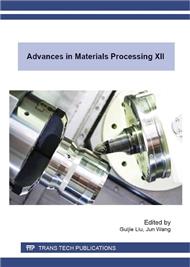p.56
p.63
p.69
p.75
p.84
p.90
p.97
p.102
p.108
Performance of a Holed-Insert in Finish-Turning of Inconel 718 under Jet Coolant
Abstract:
Nickel-based alloy has been widely used in the aerospace industry due to its excellent mechanical properties. As originally designed to retain mechanical strength under the high temperature environment, the tool wear problems normally represent in the severe flank/crater wear and corrosion during the machining process. In this study, two types of holed-insert (OHT and THT) were proposed to excite the coolant convection so as to increase the heat transfer from the insert to the coolant under the jet coolant (JC) method. As a result, JC method showed the ability of increasing the flank wear resistance, and the THT type of holed-insert extended the tool life by approximately 59% compared with the ordinary insert.
Info:
Periodical:
Pages:
84-89
Citation:
Online since:
July 2016
Authors:
Keywords:
Price:
Сopyright:
© 2016 Trans Tech Publications Ltd. All Rights Reserved
Share:
Citation:


